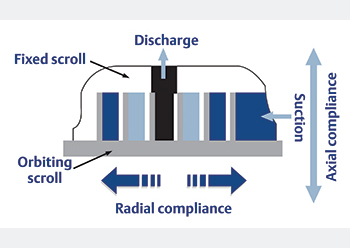Emerson puts scroll technology in spotlight
BALAN SHIVARAMAN* of Emerson Commercial & Residential Solutions, which will be showcasing its solutions with its partners at The Big 5, elaborates on the growing significance of scroll technology in the refrigeration sector.
01 November 2019
Ever since Copeland introduced scroll technology in the mid-1980s, it has been at the forefront of various heating, ventilation, air-conditioning and refrigeration (HVACR) applications. Over more than three decades, Copeland scroll has cemented its vanguard position due to its superior efficiency, reliability, ease of installation, horsepower capacity range among the comparable technologies in various applications.
It should come as no surprise that over 150 million Copeland Scroll compressors have been installed in the world. Consistent scroll innovation coupled with the ability to tailor the scroll platforms to regional requirements has been the key reason for the success of scroll in the air-conditioning market.
These superior scroll features are also the primary reasons behind Copeland Scroll’s steady advancement as the preferred technology in the refrigeration space.
 |
|
|
In the global markets such as Europe, US and China, there is a gradual transition under way from other technologies to scroll in both medium temperature and low temperature refrigeration applications. This shift in mature markets is now gaining prominence and is reinforced by continuous scroll research and development for specific applications in the refrigeration sector.
Scroll not only provides better “value for money” but also a host of other features that differentiates it from other technologies. In order to better appreciate and comprehend these features, it is important to understand the modus operandi of scroll technology.
Scroll Compression process
A scroll is an involute spiral which, when matched with a mating scroll form (Figure 1), generates a series of crescent-shaped gas pockets between the two members. During compression, one scroll remains stationary (fixed scroll) while the other scroll (orbiting scroll) is in an orbit (but not rotating) around the first form. As this motion occurs, the pockets between the two forms are slowly pushed to the centre of the two scrolls while simultaneously being reduced in volume. When they reach the centre of the scroll form, the gas – which is now at a high pressure – is discharged out of a port located at the centre. During compression, several pockets are being compressed simultaneously, resulting in a very smooth process. Both the suction process (outer portion of the scroll members) and the discharge process (inner portion) are continuous.
Scroll features
• Dual compliance: Compliance means sealing between the orbiting and fixed scroll involutes and dual compliance is sealing on both the axial and radial directions. This prevents refrigerant leak back across successive scroll pressure pockets. Compliance design also allows the scroll involutes to separate in both the radial and axial directions. This allows debris or liquid refrigerant to pass through the scroll involutes without damaging the compressor.
The benefits of dual compliance include increased efficiency; better liquid handling capability; and better handling of debris.
• Scroll wear in: The scroll involutes of Copeland scroll compressors wear in, rather than wear out. So, unlike in other compressor technologies in similar categories, there is no constant degradation of performance with time due to wear out. Instead, the performance of a scroll compressor improves with time.
• Lower sound, vibration and pulsation: The compression process in a scroll set is symmetrical and continuous. This inherently reduces the sound, vibration and pulsation, eliminating the need for the use of vibration absorbers and suction or discharge mufflers in most of the applications. In addition, scroll compressors are engineered to produce a smooth sound spectrum.
• Unloaded start: The scroll sets separate at the instant of compressor shutdown, allowing the set’s internal pressures to equalise. In addition, the scroll sets are not engaged at the instant of starting – but only after few milliseconds of start-up. This allows easier start-up of scroll compressors. Due to this design feature, typically a start assist kit is not required even on single phase compressors.
• DU bearings: These bearings, used in scroll compressors in the scroll drive and main bearings, work with exceptionally low friction between the load-bearing surfaces. In addition, DU bearings can operate safely for a short time with loss of lubrication, which could happen on applications due to oil pump out during a flooded start or heavy oil dilution after a defrost cycle.
With these features, Copeland Scroll has addressed some serious gaps in the comparable technology offerings in the markets.
Further, with Copeland’s complete line-up and range of compressors for low-, medium- and extended medium temperature applications, the company can target all applications ranging from reach-in coolers, walk-in refrigerators and walk-in freezers to ice machines.
Its network of service engineers is well equipped and trained to provide the necessary installation and commissioning support for systems built out of scroll compressors.
The refrigeration system and technology directly impact the food quality, the shelf life of perishable products, the resulting wastage and finally the health of the masses that consume these refrigerated foods. Maintaining the correct temperature during transport, storage and display of perishable goods from farm to fork is necessary to ensure optimum freshness and quality of the food. Copeland scroll provides such tailormade solutions that help customers reach their refrigeration goals.
* Balan Shivaraman is marketing manager – Emerson Commercial & Residential Solutions, Middle East & Africa.
- Seven-in-one showcase
- HVAC R Expo to launch Pioneers’ Summit
- Solar showcase to host heavyweights
- Emerson puts scroll technology in spotlight
- Emirates Steel set for robust performance



